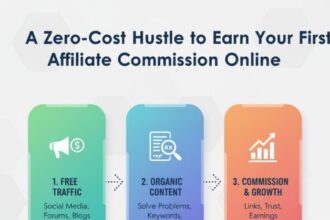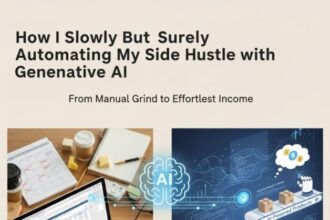The Blogging Mistakes to Avoid (Learned the Hard, Painful Way
The “Publish” button was staring at me. Mocking me. My cursor hovered over it, shaking just a little bit.
This was it. The post. My masterpiece. A 4,000-word treatise on the socio-economic impact of decorative lawn gnomes throughout history. It had wit. It had charts. It even had a few pictures I took myself. This was the one that was going to put my blog on the map.
I clicked. I published. And then I waited.
I sat there, hitting refresh on my analytics page like a rat hitting a button for a food pellet. Any second now, the graph was going to shoot up like a rocket. Any second now, the world would recognize my genius.
The next day, I checked again. Total visitors: 1. It was me. My mom didn’t even read this one.
That lawn gnome post was the glorious, flaming cherry on top of my giant sundae of failure. For my entire first year of blogging, I wasn’t just making mistakes. I was a mistake connoisseur. I was building a museum of screw-ups. It was only when I was sitting in the rubble of my own blog, surrounded by my failed posts, that I realized I had to figure this out. I had to learn about the real, painful, ego-bruising blogging mistakes to avoid: a guide for beginners. And I had to learn it from myself, because I had personally made every single one of them.
So, this is my story. This is my museum of failures. I’m opening it up to you so maybe, just maybe, you can avoid building your own.
My First Stumbles Into This Wild, Confusing World
Starting a blog feels so easy, doesn’t it? The ads make it look like a breeze. Just pick a cool name, write some stuff, and bam! You’re a blogger.
I was that person. I was that naive, bright-eyed fool.
The reality was that the moment I started, I felt like I was being pulled in a thousand different directions. Every article I read contradicted the last one. Use this theme!” “No, that theme is terrible!” “Write 500 words every day!” “No, write 5,000 words once a month!
My brain just short-circuited. I was so overwhelmed with conflicting advice that I just froze up. And in that frozen state of panic, I made my first, and probably biggest, of the common beginner errors.
The Glorious Mess of My “Junk Drawer” Blog
My first blog was about… everything. Seriously. One day, a post about my attempt to make sourdough bread (it ended badly). The next, a review of a weird foreign film my friend made me watch. After that, my deeply philosophical thoughts on why squirrels are so weirdly aggressive.
It was what I affectionately now call a Junk Drawer Blog. You know that drawer in your kitchen? The one with the dead batteries, the soy sauce packets, some rubber bands, and a single, mysterious key? That was my blog. A random assortment of stuff that made sense only to me.
This is all tied to that first, terrifying hurdle: choosing a niche. It felt like such a huge, permanent decision. What if I picked the wrong thing? The pressure was so intense that I just… didn’t pick. I chose everything, which meant I chose nothing.
Who was my blog for? I had no idea. So, naturally, it was for nobody.
I Thought My Blog Was a Baseball Field in Iowa
You know that movie, Field of Dreams? Where the ghost tells Kevin Costner, “If you build it, he will come”?
I took that advice way too literally. That was my entire blogging strategy.
So I built. I wrote and wrote. Day in, day out. I was obsessed with filling my blog with “content.” I figured if I just produced enough words, the mystical forces of the internet would recognize my hard work and bestow upon me a loving, adoring audience.
I was so focused on building my little baseball field in the middle of nowhere that I never once thought about how people were supposed to find it. I didn’t build any roads. I didn’t put up any signs. I was just there, in my empty field, playing catch with myself, wondering where everyone was. It was a lonely, lonely game.
Turns Out, So Much Blogging “Wisdom” Is a Lie
So, after months of my lonely ball game, I got frustrated. Angry, even. I felt like I was doing all the work and getting nothing back. So I started digging. Really digging. I went past the smug “Top 10” lists and started looking for real stories from real people.
And what I found was that so much of what passes for blogging advice is just a collection of myths. Hand-me-down ideas that sound good but just don’t work in the real world.
Calling out these myths, even just in my own head, was like turning on a light in a dark room. It meant I wasn’t crazy. I hadn’t been failing because I was a uniquely bad blogger; I was failing because I was following directions to a place called Fantasyland.
The “Lonely Genius” Myth That Almost Killed Me
I had this vision of a blogger. You know the type. A brilliant, solitary writer, creating masterpieces from a cozy, book-lined room. They’d craft the perfect post, release it to the world, and the world would swoon.
This is a beautiful, romantic lie.
Content creation is what you think blogging is. And yes, it’s important. But from what I’ve painfully learned, it’s about 40% of the job. At best. The other 60%? It’s being a marketer. A promoter. A town crier.
I used to spend 100% of my time on the writing part. I’d tweak and polish a post for a week. Then I’d publish it… and move on to the next one. I was terrified of “self-promotion.” It felt arrogant. It felt icky.
But a post that you don’t promote is a secret. And nobody is going to read your secret diary. Actively promoting your blog isn’t an act of ego; it’s an act of respect for the work you just did. A hard-won lesson I found echoed in many business case studies, like this one on content marketing from the Content Marketing Institute: without promotion, content dies. I had to learn to get over myself and actually tell people my blog existed.
The “Catch a Unicorn” Viral Myth
Ah, the dream of “going viral.” That one post that gets a million shares. The one that gets you on the morning news. The one that changes everything overnight.
We all want it. And that desire is a trap.
I wasted so much time trying to chase virality. I’d try to write posts that were “controversial” or had clickbait-y titles. I was trying to engineer a unicorn.
But you can’t engineer a unicorn. It’s luck. Pure, dumb, random luck. And even if you do catch that unicorn, what then? You get a giant flood of traffic from people who don’t actually care about your blog. They’re there for the one weird thing, and then they’re gone forever. It’s a sugar high, not a sustainable diet.
Every real, successful blog I’ve studied since was built on a foundation of hundreds of useful, helpful, “boring” posts. They built their house brick by brick, not by waiting for a magic castle to fall out of the sky.
The Myth That My Story Is Interesting
This one stings. It’s the one I fight every single day.
When I started my blog, I thought it was about me. My journey. My opinions. My fascinating life. (Spoiler: my life is not that fascinating). So my posts were filled with “I think…” and “I feel…” and “Here’s a story about what I did last Tuesday…”
And nobody cared.
They didn’t care about my story because they didn’t know me. Why would they? They didn’t come to my blog to learn about me. They came because they had a problem, and they were desperately, selfishly looking for an answer.
My blog wasn’t helpful because it was a memoir, and nobody had bought a ticket to see the movie of my life. The moment things started to shift was when I changed one simple thing. I stopped talking about “I” and started talking about “You.” I forced myself to see my blog through the reader’s eyes. And from their perspective, my personal stories were just getting in the way.
The Simple, Obvious Idea That Finally Flipped a Switch in My Head
I was burnt out. I was a failed writer, a failed marketer, and the world’s leading expert on my mom’s reading habits. I was so close to just deleting the whole thing. It was just too much, and nothing was working.
The “aha!” moment wasn’t some bolt of lightning. It was a slow, quiet realization. It was the answer to one simple question: What if I wasn’t the main character in this story?
The whole time, I had been thinking of my blog as a stage, and I was the star performer. But that was the problem. A successful blog isn’t a stage.
It’s a party. And the blogger isn’t the star. They’re the host.
Am I a Performer or a Host?
This one idea changed my entire universe. It’s the key to everything.
Think about a performer on a stage. Their focus is inward. On their lines. On their performance. On their art. They are delivering a monologue.
Now, think about the host of a really good party. Their focus is completely outward. On their guests. Are people comfortable? Does everyone have a drink? Is the music too loud? Can people find their way around? Their entire goal is to make sure everyone else is having a good experience.
For a year, my blog was a party where the host stood in the corner, facing the wall, and recited poetry to himself. It was a weird, awkward, and deeply un-fun party. This is the heart of real reader engagement. It’s not a tactic. It’s an act of hospitality. As I explored in a previous post, [Are You a Host or a Ghost?], your presence and focus on the reader makes all the difference.
The moment I saw myself as a host instead of a performer, my priorities scrambled and re-formed in a completely new, and much more helpful, order.
My blog wasn’t my personal diary anymore. It wasn’t a soapbox for my opinions. It was a service. A space I was creating and maintaining for other people.
This sounds so simple, but it was a revolutionary idea for me. It meant every decision, from the topics I chose to the size of the font on the page, had to be run through a new filter: Does this serve my guest? Is this helpful? Does this make their experience better? It stopped being about my ego, and it started being about my service.
My “Don’t Do What I Did” Field Guide to Blogging
So, after crawling out from under my mountain of fail, what do I actually do differently now? This isn’t some slick, 7-step formula I bought from a guru. This is a messy, battle-scarred checklist I’ve built for myself. It’s my personal guide to the big blogging mistakes to avoid. I hope it can be a shortcut for you, saving you from at least a few of the face-plants I so gracefully executed.
1. I Refuse to Write for “Everyone”
My Junk Drawer Blog was for “everyone,” which meant it was for no one. My very first step in my new content creation process is to get brutally specific about who my guest is. Not “people who like food.” It’s “busy moms who want to cook a healthy meal in under 30 minutes.” Not “people who like movies.” It’s “college students looking for classic sci-fi films they might have missed.”
I picture one single, specific person. I give them a name. I think about their problems. Their frustrations. Their goals. And then I write every single post just for them. It feels weirdly personal, and yet it’s what creates a real connection. Because when you try to be for everyone, you end up being for no one at all.
2. The 50/50 Rule: My New Religion
This was the hardest change for me to make, but it had the biggest impact. I used to spend 100% of my time writing and 0% of my time promoting. My blog was a secret, and I was mad no one was finding it. Crazy, right?
Now, I live and die by the 50/50 rule. If a post takes me six hours to research, write, and edit, then I am morally obligated to spend the next six hours on promoting your blog.
What does that look like?
Targeted Sharing: I don’t just blast my link to every social media platform. I find the one or two specific subreddits, Facebook groups, or Pinterest boards where my ideal reader (the one I pictured in step #1) actually spends their time.
Being a Helper, Not a Spammer: I don’t just drop a link and run. I find a relevant conversation or a question being asked, and I provide a genuine, helpful answer right there in the comments. Then, and only then, do I say, “Hey, if you want to go deeper on this, I actually wrote a whole post about it here.”
The Friendly Nudge: If I mentioned another blogger or a cool product in my post, I’ll send them a short, no-strings-attached email. “Hey, just wanted to let you know I’m a huge fan of your work and shouted you out in my latest post. Keep being awesome.” That’s it. It’s about building bridges, not asking for favors.
3. I Became an Email List Obsessive
This is my biggest regret. My most painful mistake. For over a year, I had people visiting my site (okay, a few dozen) who came and then left forever. I had absolutely no way of ever reaching them again. It was like making a new friend at a concert and then walking away without getting their number.
Now, building an email list is priority number one. Your email list is the only audience you truly own. You’re not borrowing them from Facebook or Google. They’ve given you permission to show up in their inbox. That’s an incredible privilege. Even a simple offer like, “Enjoyed this? Sign up to get my new posts delivered to your inbox,” is enough to get started. Data from companies like Litmus consistently shows that email is one of the most effective channels for building a loyal following. It’s your direct line to your biggest fans. Don’t wait. Don’t make the same mistake I did.
4. I Treat My Blog Like a Physical Space
I’ve started thinking of my blog’s design and layout as if it were a real, physical place, like a cozy bookstore or a coffee shop. And I, the host, want to make it as comfortable as possible.
Is it easy to read? I’m now a tyrant about this. I use big, clear fonts. Lots of white space. And my paragraphs are now tiny. One to three sentences, max. Big, dense walls of text are the visual equivalent of shouting at your guests. It’s stressful.
Is it cluttered? I used to have a million things in my sidebar. Ads, widgets, links to everything. It looked like a hoarder’s garage. Now, I keep it clean and minimal. The focus should be on the content, on the conversation. As I talked about in a previous post, [The Joy of Deleting Half My Blog], simplifying my design was incredibly freeing.
Do I have a plan to make money later? In my desperation, I tried to slap ads all over my blog when it was brand new and getting no traffic. It looked cheap and tacky. It was like trying to busk for change before I’d even learned to play the guitar. My focus now is 100% on being helpful and building an audience. The monetization strategies can, and should, come later, once you’ve actually earned your readers’ trust.
So, Where Does That Leave Me? Still Making Mistakes.
I’m not going to sit here and tell you that I’ve figured it all out. I’m not a guru. I’m not a millionaire blogger. I’m still just a guy with a website, trying his best.
But I’m not in that same dark, frustrating place anymore. I’m not collecting the same mistakes. I’m making new, more interesting ones now! That’s progress, right?
The silence isn’t so deafening anymore. There are people here now. There are comments and emails and a slowly growing community. Not because I found a magic bullet, but because I stopped trying to be a star and started trying to be a host. I stopped making it about me, and I started making it about you.
This whole journey has been a lesson in humility. It’s been about accepting that I didn’t have the answers and that the only way to find them was to listen. To listen to the data, to the readers, and to the quiet whispers of my own spectacular failures. They had a lot to teach me.
What’s the one big mistake you’ve made that ended up being your greatest teacher?































